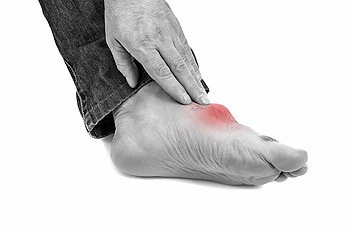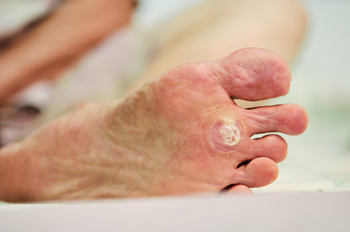Items filtered by date: April 2021
Different Types of Foot Wounds
 Foot wounds are open cuts or sores that form on the feet. There are several different types of foot wounds. Diabetic foot ulcers (DFUs) occur due to diabetes or diabetic neuropathy. They can appear anywhere on the foot, but often appear on the big toes, balls of the feet, and the heels. These wounds typically heal slowly and poorly. Venous stasis ulcers appear on the ankles or legs due to vein damage. Arterial ulcers are caused by arterial insufficiency or poor circulation, and usually occur between or on the tips of the toes and along the outer ankles. A pressure ulcer is caused by foot immobility or by wearing improper shoes. They are usually seen on the heels or ankles. If you have any wounds on your feet, it is strongly suggested that you seek the care of a podiatrist.
Foot wounds are open cuts or sores that form on the feet. There are several different types of foot wounds. Diabetic foot ulcers (DFUs) occur due to diabetes or diabetic neuropathy. They can appear anywhere on the foot, but often appear on the big toes, balls of the feet, and the heels. These wounds typically heal slowly and poorly. Venous stasis ulcers appear on the ankles or legs due to vein damage. Arterial ulcers are caused by arterial insufficiency or poor circulation, and usually occur between or on the tips of the toes and along the outer ankles. A pressure ulcer is caused by foot immobility or by wearing improper shoes. They are usually seen on the heels or ankles. If you have any wounds on your feet, it is strongly suggested that you seek the care of a podiatrist.
Wound care is an important part in dealing with diabetes. If you have diabetes and a foot wound or would like more information about wound care for diabetics, consult with Dr. Odin De Los Reyes from Connecticut. Our doctor will assess your condition and provide you with quality foot and ankle treatment.
What Is Wound Care?
Wound care is the practice of taking proper care of a wound. This can range from the smallest to the largest of wounds. While everyone can benefit from proper wound care, it is much more important for diabetics. Diabetics often suffer from poor blood circulation which causes wounds to heal much slower than they would in a non-diabetic.
What Is the Importance of Wound Care?
While it may not seem apparent with small ulcers on the foot, for diabetics, any size ulcer can become infected. Diabetics often also suffer from neuropathy, or nerve loss. This means they might not even feel when they have an ulcer on their foot. If the wound becomes severely infected, amputation may be necessary. Therefore, it is of the upmost importance to properly care for any and all foot wounds.
How to Care for Wounds
The best way to care for foot wounds is to prevent them. For diabetics, this means daily inspections of the feet for any signs of abnormalities or ulcers. It is also recommended to see a podiatrist several times a year for a foot inspection. If you do have an ulcer, run the wound under water to clear dirt from the wound; then apply antibiotic ointment to the wound and cover with a bandage. Bandages should be changed daily and keeping pressure off the wound is smart. It is advised to see a podiatrist, who can keep an eye on it.
If you have any questions, please feel free to contact our offices located in Southbury and Farmington, CT . We offer the newest diagnostic and treatment technologies for all your foot care needs.
Heel Pain Can Be Treated!
Surgery for Ingrown Toenails
Ingrown toenails are often relatively harmless and heal on their own. Conservative treatment methods such as wearing roomier shoes and soaking the feet in warm water is usually enough to relieve pain and heal the nail. However, some ingrown toenails can be severe, become infected, or can frequently recur. In these cases, surgery may be suggested. Acute inflammation or infection may be treated by surgically removing a small portion of the ingrown nail. In very severe cases, where the toenail has become very deformed or severely infected, the entire nail may need to be removed. If you are prone to ingrown toenails, or have an ingrown nail that you suspect is infected, please consult with a podiatrist to find the right treatment for you.
Ingrown toenails can become painful if they are not treated properly. For more information about ingrown toenails, contact Dr. Odin De Los Reyes of Connecticut. Our doctor can provide the care you need to keep you pain-free and on your feet.
Ingrown Toenails
Ingrown toenails occur when a toenail grows sideways into the bed of the nail, causing pain, swelling, and possibly infection.
Causes
- Bacterial infections
- Improper nail cutting such as cutting it too short or not straight across
- Trauma to the toe, such as stubbing, which causes the nail to grow back irregularly
- Ill-fitting shoes that bunch the toes too close together
- Genetic predisposition
Prevention
Because ingrown toenails are not something found outside of shoe-wearing cultures, going barefoot as often as possible will decrease the likeliness of developing ingrown toenails. Wearing proper fitting shoes and using proper cutting techniques will also help decrease your risk of developing ingrown toenails.
Treatment
Ingrown toenails are a very treatable foot condition. In minor cases, soaking the affected area in salt or antibacterial soaps will not only help with the ingrown nail itself, but also help prevent any infections from occurring. In more severe cases, surgery is an option. In either case, speaking to your podiatrist about this condition will help you get a better understanding of specific treatment options that are right for you.
If you have any questions please feel free to contact our offices located in Southbury and Farmington, CT . We offer the newest diagnostic and treatment technologies for all your foot and ankle needs.
Gout Can Produce Extreme Pain
 The most common form of inflammatory arthritis is referred to as gout. It is a condition that affects approximately four percent of Americans, and can be caused by genetic factors and eating habits. Common symptoms of this foot condition can include extreme tenderness, debilitating pain in the joints of the big toe, possibly causing difficulty in walking, and the toe may appear to be swollen. Some of the foods that can cause gout to develop include shellfish, red meat, and drinks that are made with large amounts of sugar. The pain comes from excess uric acid caused by elevated purine amounts that form in the joints, and can produce sensations that can feel like crystals in the feet. Mild relief may be found when lifestyle changes occur that include reducing the amount of food that is eaten with high purine levels. If you have frequent gout attacks, it is strongly advised that you are under the care of a podiatrist who can help you with proper treatment and prevention options.
The most common form of inflammatory arthritis is referred to as gout. It is a condition that affects approximately four percent of Americans, and can be caused by genetic factors and eating habits. Common symptoms of this foot condition can include extreme tenderness, debilitating pain in the joints of the big toe, possibly causing difficulty in walking, and the toe may appear to be swollen. Some of the foods that can cause gout to develop include shellfish, red meat, and drinks that are made with large amounts of sugar. The pain comes from excess uric acid caused by elevated purine amounts that form in the joints, and can produce sensations that can feel like crystals in the feet. Mild relief may be found when lifestyle changes occur that include reducing the amount of food that is eaten with high purine levels. If you have frequent gout attacks, it is strongly advised that you are under the care of a podiatrist who can help you with proper treatment and prevention options.
Gout is a painful condition that can be treated. If you are seeking treatment, contact Dr. Odin De Los Reyes from Connecticut. Our doctor will treat your foot and ankle needs.
What Is Gout?
Gout is a form of arthritis that is characterized by sudden, severe attacks of pain, redness, and tenderness in the joints. The condition usually affects the joint at the base of the big toe. A gout attack can occur at any random time, such as the middle of the night while you are asleep.
Symptoms
- Intense Joint Pain - Usually around the large joint of your big toe, and it most severe within the first four to twelve hours
- Lingering Discomfort - Joint discomfort may last from a few days to a few weeks
- Inflammation and Redness -Affected joints may become swollen, tender, warm and red
- Limited Range of Motion - May experience a decrease in joint mobility
Risk Factors
- Genetics - If family members have gout, you’re more likely to have it
- Medications - Diuretic medications can raise uric acid levels
- Gender/Age - Gout is more common in men until the age of 60. It is believed that estrogen protects women until that point
- Diet - Eating red meat and shellfish increases your risk
- Alcohol - Having more than two alcoholic drinks per day increases your risk
- Obesity - Obese people are at a higher risk for gout
Prior to visiting your podiatrist to receive treatment for gout, there are a few things you should do beforehand. If you have gout you should write down your symptoms--including when they started and how often you experience them, important medical information you may have, and any questions you may have. Writing down these three things will help your podiatrist in assessing your specific situation so that he or she may provide the best route of treatment for you.
If you have any questions, please feel free to contact our offices located in Southbury and Farmington, CT . We offer the newest diagnostic and treatment technologies for all your foot care needs.
Can Children Get Plantar Warts?
 The papillomavirus is responsible for warts in both adults and children. Although pediatric warts are said to be more common, anyone can become affected. Warts are usually not painful unless they occur on the soles of the feet, as is the case with plantar warts. These flat, thick, callus-like warts can grow singularly or even in a cluster, causing a “mosaic” on the bottom of the feet. Sometimes small black dots, which are clotted blood vessels, may be visible within the wart. While warts usually go away after some time, they can be quite tender and stubborn. If your child has developed plantar warts that are painful or persistent, it is suggested that you make an appointment with a podiatrist. A podiatrist can use a variety of medicines and treatments depending on the severity of the warts, your child’s age, medical history, and tolerance for medical procedures.
The papillomavirus is responsible for warts in both adults and children. Although pediatric warts are said to be more common, anyone can become affected. Warts are usually not painful unless they occur on the soles of the feet, as is the case with plantar warts. These flat, thick, callus-like warts can grow singularly or even in a cluster, causing a “mosaic” on the bottom of the feet. Sometimes small black dots, which are clotted blood vessels, may be visible within the wart. While warts usually go away after some time, they can be quite tender and stubborn. If your child has developed plantar warts that are painful or persistent, it is suggested that you make an appointment with a podiatrist. A podiatrist can use a variety of medicines and treatments depending on the severity of the warts, your child’s age, medical history, and tolerance for medical procedures.
Plantar warts can be very uncomfortable. If you need your feet checked, contact Dr. Odin De Los Reyes from Connecticut. Our doctor will assist you with all of your foot and ankle needs.
About Plantar Warts
Plantar warts are the result of HPV, or human papillomavirus, getting into open wounds on the feet. They are mostly found on the heels or balls of the feet.
While plantar warts are generally harmless, those experiencing excessive pain or those suffering from diabetes or a compromised immune system require immediate medical care. Plantar warts are easily diagnosed, usually through scraping off a bit of rough skin or by getting a biopsy.
Symptoms
- Lesions on the bottom of your feet, usually rough and grainy
- Hard or thick callused spots
- Wart seeds, which are small clotted blood vessels that look like little black spots
- Pain, discomfort, or tenderness of your feet when walking or standing
Treatment
- Freezing
- Electric tool removal
- Laser Treatment
- Topical Creams (prescription only)
- Over-the-counter medications
To help prevent developing plantar warts, avoid walking barefoot over abrasive surfaces that can cause cuts or wounds for HPV to get into. Avoiding direct contact with other warts, as well as not picking or rubbing existing warts, can help prevent the further spread of plantar warts. However, if you think you have developed plantar warts, speak to your podiatrist. He or she can diagnose the warts on your feet and recommend the appropriate treatment options.
If you have any questions please feel free to contact our offices located in Southbury and Farmington, CT . We offer the newest diagnostic and treatment technologies for all your foot and ankle needs.


